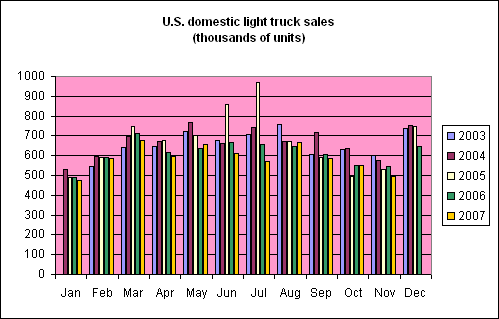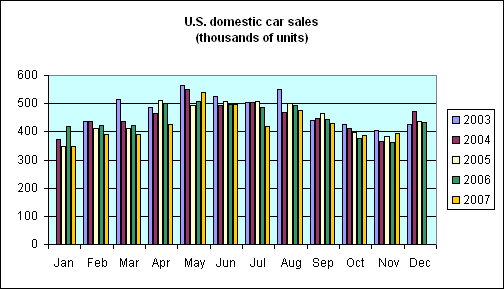Weakness in autos, but it’s not as bad as it could be.
Seasonally unadjusted sales of light trucks (which includes SUVs) manufactured in North America fell 9.8% between October and November. That puts them 9.1% below the value for November 2006 and down 17.7% from November 2003.
 |
Domestic cars (excludes light trucks) made up some of the difference, with sales up 1.2% month-to-month and up 8.5% year-to-year. That leaves November 2007 sales of domestic cars only 3.3% below the value of November 2003.
 |
It seems reasonable to attribute the shift from SUVs to cars to higher gasoline prices.
 |
Selling fewer trucks and more cars will help the U.S. in terms of fuel efficiency, but is not a wash for domestic manufacturers, whose total number of units sold as well as profitability per unit are both down. The November numbers thus represent a continuation of an unfavorable trend from the perspective of domestic manufacturers. The Wall Street Journal reported:
GM and Ford yesterday outlined production cuts aimed at keeping output in line with falling demand. GM said it would build 950,000 vehicles during the first three months of 2008, down 11% from the year-earlier period. Ford cut its first-quarter production forecast 7.4% to 685,000 vehicles.
 |
On the basis of these numbers, we might anticipate motor vehicles to be one factor slowing GDP growth during the fourth quarter, though not precipitously.
Another key indicator of whether the fall run-up in fuel prices is making a difference for consumer spending are the surveys of consumer confidence conducted separately by the Conference Board and the University of Michigan. Both are beginning to give me some concern.
 |
Technorati Tags: macroeconomics,
autos,
auto+sales,
consumer confidence,
economics,
recession,
oil prices,
oil,
oil shocks,
Another colorful (and informative –even for color challenged me) bar graph on that other American Dream, the one with a little wider appeal than the 67% home ownnership rate, cruising for burgers. [The auto ownership rate deserves far more attention, no?]
Only a couple of things to add/subtract: the (conservative…just tis) note that the 9.8% decline in autos (Sept -> Oct) in autos is not “precipitous”…is more than an offense to the English language (…an extraordinary liberty with English style).
Tis.
No matter how you try to rescue this with the astute observation that car sales actually increased (and the equally astute neglect of the miserable truck sales). No matter how astute that observation about the evidence of fuel prices coming to bear on auto sales.
Not much of a subtraction, yet?
Ok, what of that panoramic picture given by the graph esp pre-2005, that auto sales look like they keep pace with population? On a per capita basis shouldn’t we expect “flat” sales to really increase 2-3%?
Now the adding: consumer sentiment for me is tied to auto sales (alright, alright: sub-compact fuel misers especially) which are a statement of consumer’s ability to put their money where those more fickle “sentiments” are, yes? Right now I would think consumer sentiments are the least of our worries as consumption behavior ebbs from the economy –no matter what notions are lodged between their ears to the contrary.
Funny how much respect we (not just JDH or even JDH) give certain consumer “expectations” and how the “subprime crisis” is making us downright cynical about any expectations.
Ok, maybe not so funny.
“It seems reasonable to attribute the shift from SUVs to cars to higher gasoline prices.”
That reality and the real possibly of the slowdown in housing (as equipment), and possibly because light trucks are durable goods so their replenishing cycle has a longer period.
Domestic cars (excludes light trucks) are also durable goods so their replenishing cycle also has a longer period.
What would be interesting is identifying the relationship between the number of drivers, their income strata, and the sales of light trucks (which includes SUVs) and domestics.
WSJ reports that auto loans are going bad at an increasing rate, with those more than 30 days behind rising sharply month over month. This is surprising in light of the ADP payroll numbers, since I would expect auto loans to be closely correlated with employment. In any event, this will impact the used car market and to some extent,and put a further damper on new car and truck sales.
Careening off David and Grze,
The reality that light trucks (F150 Ford until recently the #1 selling vehicle in the US for years…I can get over it, I must.) can no longer be discarded as a business interest/expense…means future truck sales will be facing stiff competition from their slightly used predecessors. A case of the F150 being too durable? or just the depreciation allowances too generous?
Grze’s (who could be multi-lingual and passing me strange ones) idea that the auto is “replenished” with the business cycle…not with its warranty or durability, is new to me…such is my bone-headed way of looking at cause and effect. Are you “with” me? [I’m trying to be with you.] The all pervading ‘business cycle’ from boom to bust causes this particular effect: trucks are sold…or not. [Of course, I struggle just to keep 1 language serviceable.] Is the marketing as successful as this: the new truck is proof that the business cycle for you is booming again. The truck proves it…until it sits in the front yard because you can’t afford the gas to keep up the pretense.
Sorta.
David notes:
This is surprising in light of the ADP payroll numbers, since I would expect auto loans to be closely correlated with employment.
and this seems reasonable enough until you visit a large site and see just how many of those employees are busing…not everybody gets to deduct the truck as an expense…lots of the undocumented workers (but still making it onto the payroll) without driver’s licences.
Agree, though, with the deterioration even before the housing peak in 05 –“auto loans are going bad at an increasing rate”. If you aren’t driving, you are nobody…so “subprime” lending practices made their debut with GMAC (prolly others too) teasing buyers already in default into newer more expensive, longer term loans.